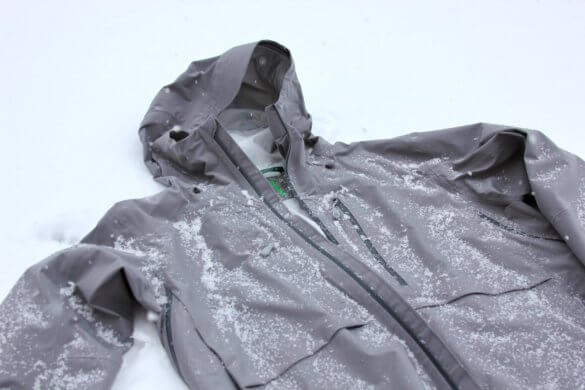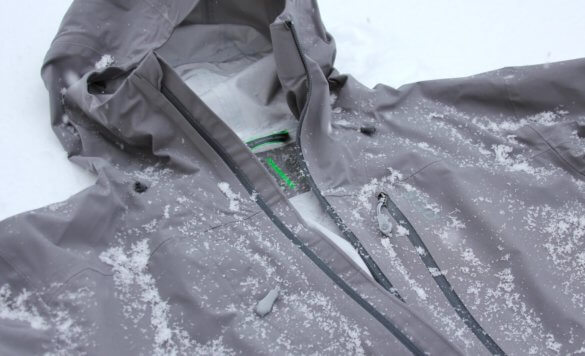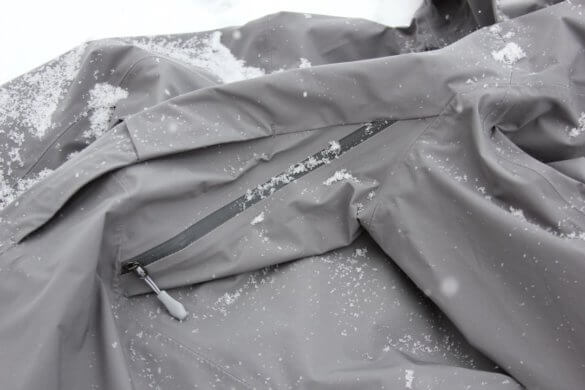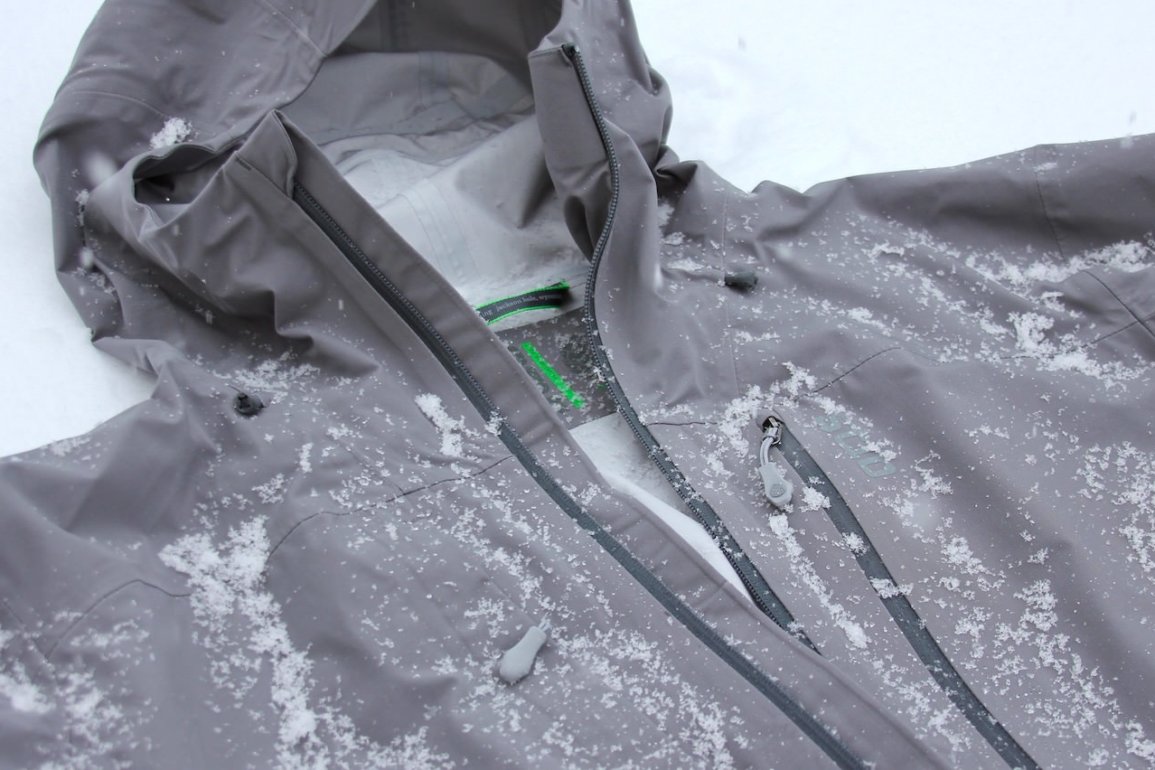The new Stio Raymer Jacket is a waterproof, breathable and lightweight shell designed for hard-charging skiers. While it was created for rigorous alpine touring and backcountry skiing, the Raymer is also great for lap-counting inbound skiers — and anyone who just wants a high-quality lightweight ski shell.
To get us a closer look, Stio sent Man Makes Fire a review unit. This is what we learned:
Stio Raymer Jacket Review
The Stio Raymer Jacket is an uninsulated shell, which means it’s meant for layering — you need to wear a warm base layer and likely a good midlayer underneath the jacket to stay warm. The waterproof shell protects you from the elements while layering lets you choose your own insulation for the temperatures and activities you’re facing.

At the same time, the Raymer is breathable, so if you work up a good bit of body heat and perspire, the fabric will let moisture escape. If you’re trying to earn your turns and find untracked snow by climbing on foot, you’re going to heat up fast, so the breathability feature of a high-quality ski shell is critical.
Of course, you don’t have to be a dawn patrol addict to benefit from the Stio Raymer, which is where we come in: Our primary interest is what happens in-bounds during whatever moment we can carve out to get in as many runs as possible. While most ski resort skiers and snowboarders can get by with most any insulated ski coat or waterproof shell, using great gear can make your limited time on the mountain even more enjoyable. And for us, a great ski shell basically lets us hit a few more runs when the weather gets bad — or the snow is particularly awesome.
Why Choose the Stio Raymer?

Stio is an outdoor, mountain-focused clothing company based out of Jackson Hole, Wyoming that makes both technical outdoor clothing as well as everyday mountain-style apparel. Last year we reviewed the excellent Stio Pinion down jacket, and more recently, put the customer-favorite Stio Environ Jacket through some laps. While reviewing the Environ, we appreciated how well it performed overall, in addition to its burly durability. And that experience begged the question: Would the lighter Raymer be a better ski shell? For whom? And for what situations?
So here we are. The short answer is this: The Raymer is designed for more hard-core activity where lighter is better and improved breathability is appreciated. The Raymer weighs in at about 18 ounces while the Environ is about 31 ounces — that’s a 13-ounce difference, which is nice if you’re slogging uphill. Plus, the breathability rating is a very respectable 13,000g (which is a bit more breathable than the Environ’s solid 10,000g rating).
Meanwhile, what about the overall design?
Design & Materials
The Stio Raymer uses a stretchy, fully seam-sealed Toray Entrant 3L shell material. It’s a 100% nylon with a 50-denier face fabric and microporous membrane that delivers a fantastic 20,000mm waterproofness rating with the aforementioned 13,000g breathability rating. The exterior also uses a DWR coating to help repel water.
As you might expect, Stio constructed the Raymer to be ready for backcountry use. For instance, the zippered hand pockets are positioned a bit higher to make them accessible while wearing a backpack with a waist or hip belt.
You also get two chest pockets with bellows at the bottom that let them expand a bit with contents. They overlap some with the hand pockets below, but the bellows help push any bulk outward if you’ve filled all of your pockets.
You also get one zippered interior stash pocket on the left-hand side. It’s about the size and shape of a large smartphone.
Core Vents
Instead of more traditional pit zips, the Stio Raymer uses angled zippered core vents. They’re positioned a bit lower and forward and they still work well for dumping excess heat.

The hood is, of course, helmet compatible. You can adjust the fit with drawcords, and it’s easy to dial-in. Visibility with a helmet is decent, too.
Stio ditched a powder skirt, but the hem does have a drawcord for sealing out drafts (and most snow).
So far we’ve been fans of all Stio zippers we’ve seen, and the Raymer’s are also excellent. The zippers aren’t waterproof, but they’re water-resistant and work well. One design feature we really appreciate is the small but surprisingly effective silicone zipper pulls. We can find these while wearing gloves and mittens they just work way better than we ever expected. We’ve run into gear from much larger brands that haven’t figured out great zipper pulls — but Stio has.
The main center zipper is a bi-directional zipper that lets you zip the jacket normally . . . but then unzip it from the bottom up. This is handy for calls of nature. It also offers another option for fast ventilation when you don’t want to mess with your hood and collar.
Check out color options for the Stio Raymer and get FREE Shipping on orders over $49!
Fit & Finish
The overall fit is a regular fit, which is Stio’s medium/standard sort of cut. Stio says it’s roomier than its “trim” fit but it’s still designed with athletic performance in mind. What’s that mean? The men’s XL fit spot on to what we expect. It’s trim enough to feel fine with minimal layering, but it can easily handle a merino wool base layer, a lightweight fleece pullover, and/or a light insulated midlayer-type jacket (obviously all of this depends on how thick and well-fitted these layers are).
Either way, the overall fit gives you versatility without feeling bulky.
Sleeve length is good, and the velcro cuffs are widely adjustable.
The fabric itself is more supple than the 150-denier fabric in the Stio Environ shell, but it still feels surprisingly tough. No qualms with it here. In fact, we’re big fans already and expect to see it hold up well over time.
Stio Raymer Review: The Verdict
Overall, the Stio Raymer has the same bomber quality we saw in the Stio Environ — the sealed seams are done well, the stitching is fantastic, and the details are dialed in — but it is made with a thinner, more supple fabric. While most people would do well with either the Environ or the Raymer, it’s important to remember that you don’t have to be an expert to appreciate a great waterproof breathable ski/snowboard shell. If you’re looking for a lightweight, breathable ski shell that is supple-yet-solid, you can’t go wrong with the Stio Raymer. Very highly recommended.
Get the Gear:
- Stio Raymer – men’s
- Stio Environ – men’s
- Stio Raymer – women’s
- Stio Environ – women’s





